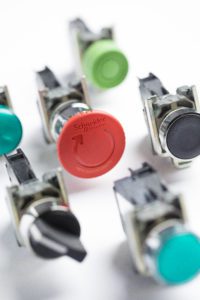I’ve began my professional life if Japan and one memory from that early time is that each day on the work floor of the factory would begin with warm-up exercises. The reason behind this peculiar tradition was to avoid accidents for employees moving heavy loads or taking stressful positions during their tasks.
Around the world, various solutions are implemented to prevent such issues, including various ergonomic design of machines and workstations to ensure Safety standards like, EN 894-1 Safety of machinery – Ergonomics requirements for the design of displays and control actuators.
However, ergonomics can be implemented even further and can bring much more advantages when included into the design of machines. Especially when applied to the design of the control interface of your machines, ergonomics can help :
- Reduce the training time of new operators by making the control interface more intuitive
- Enable quicker operations by optimizing the interface for less movements during consecutive actions
- Avoid operator errors, with easier to understand indications & controls
- Enable quicker reactions in case of unusual situations, like alarms
On top of that, machine ergonomics can also increase operator engagement by
- Enabling more comfortable & easy to use control interfaces
- Decreasing the mental stress by reducing the information overload in case of unusual situations
Hooked-up and wondering what are the best practices to include enhanced ergonomics in your own design ? Here is a couple of practical tips to begin with :
- Optimize your controls & indicators position inside the operator field of view
By increasing their visibility, you will make the operator actions more intuitive and reactive. For example, the optimum position for alarms is aligned with the operator eyes. A light turned on at eye level will attract much more attention that the same light located 30 cm down.
Similarly, controls ought to be classified by importance, with the most important ones closest to the middle between the 2 hands of the operator.
According to the standing or sitting position, the areas of optimum attention within the operator field of view are slightly different.
Here an example of a control interface with the alarm and emergency stop button located next to the HMI screen in order to be well positioned in the operator field of view
2. Optimize your controls & indicators position inside the operator range of movement
Once you have considered the area the operator can easily see, the next step is to consider the areas he can easily reach, which can be called his range of movement.
Even standing, the natural position of our arms is to keep the elbows down, so that reaching at hip to breast level is the less tiring movement and reaching above our shoulders is usually stressful.
Similarly keeping our elbows in their naturally bent position is defining the area that operators can reach quickly without hurting themselves in the long term. This area is where the most often used controls and the functions requiring quick actions should be placed.
Controls often used or requiring quick reflex actions should be placed in the most comfortable & easy to reach area
To foster quick and efficient movements, placing together and in the right order controls involved in a sequence of actions is a paramount importance.
Another trick is to avoid obstacles on the operator hand trajectory. Selector switches with their high handles can be such obstacles, forcing the operator hand to move higher than usual which is both slowing down the actual movement and sending messages to our brains that if there is a wall it may not be good to cross it. To avoid this issue, it is possible either to use flush mounting operator, which is enabling you to lower the high of the obstacle, or you can just chose to move your selector switch to a position it would be less of an obstacle.
If placed in the middle, the selector switch can bother the travel of the operator hand between the 2 pushbuttons at the bottom
Finally another example of taking into account the operator range of movement is thinking about the possibility to have left-handed and right-handed operators. If you want to have a reflex action, like the activation of an emergency stop, to be easy to accomplish independently of the strong hand of the operator, you ought to locate the relevant control in the middle of your control interface.
An emergency stop located in the middle of the interface is easy to actuate by both left-handed & right-handed operators.
Discover more tips in our “Building efficient operator workstations” brochure
Or begin using our Product Selector & Customization tool to design your control interface.
If you want to share your own trick and tips, don’t hesitate to use the comments.



